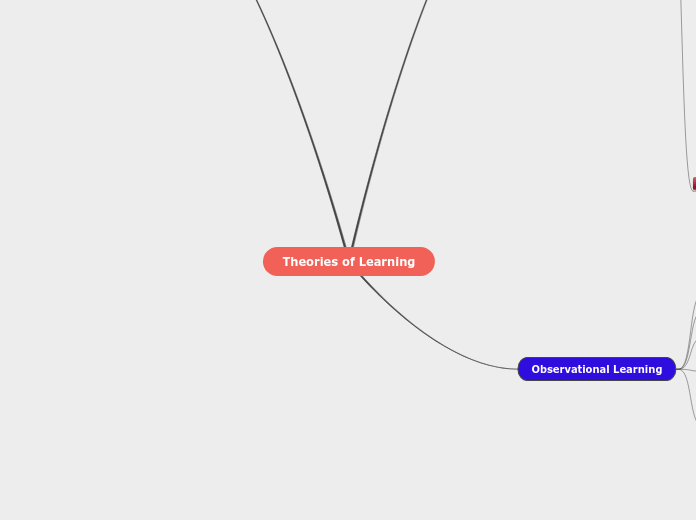Theories of Learning
Operant Conditioning
A form of learning in which consequences for behaviour, changes the likelihood that the behaviour will occur in the future
Known is "Instrumental Conditioning"
First studied by Thorndike
Developed Law of Effect
Behaviours are followed by positive outcomes are strengthened. Behaviours followed by negative outcomes are weakened.
Performed the "Puzzle Box" experiment
Placed cats inside the box
Wanted to learn how cats would get out
Put food outside of the box
The cats would come out
B.F Skinner was the main researcher
Worked with pigeons and rats
Taught rats to press a lever and go through mazes
Taught pigeons many complex tasks
Built on Reinforcement and Punishments
Reinforcement is a type of consequence that increase the likelihood of a behaviour
Positive Reinforcement (+)
Adding something positive after a behaviour is observed
An example is when a father gives candy to their daughter for cleaning her room
Negative Reinforcement (-)
Taking away something negative after a behaviour observed
An example of this a son does the dishes so his mom can stop yelling at him
Punishment is a type of consequence that decrease the likelihood of a behaviour happening again
Positive Punishment (+)
Adding a stimulus to prevent that behaviour from happening again
An example of this is a mom giving their child a time out for lying
Negative Punishment (-)
Removing a stimulus to prevent that behaviour from happening again
An example, a child is not allowed to go out (grounded) for talking back.
Reinforcement
Continuous reinforcement- reinforcement for every occurrence of the targeted behaviour
Partial reinforcement- reinforcement that is occasional or intermittent (most of the time reinforcement is partial)
Schedules of Reinforcement
Fixed-Ratio Schedule
A behaviour is reinforced after a set number of responses
Ex. A man receives $5 for every box he makes
Variable-Ratio Schedule
A behaviour is reinforced after an average number of times, but on an unpredictable bases
Ex. A charity makes an average of 15 phone cals for every donation received
Fixed- Interval Schedule
The first appropriate response after a fixed amount of time is reinforced
Ex. Checking the oven to see if Cookes are done when baking time is known
Variable-Interval Schedule
A response is reinforced after a variable amount of time has elapsed
Ex. Watching and seeing shooting starts on a dark night
The Premack Principle
Idea that an undesired task must be completed before you may engage in a reinforcing activity
Ex. "Eat all your vegetables and you can have dessert"
Observational Learning
A type of learning that happens when a person observes and imitates someone else's behaviour.
Discovered by Albert Bandura
Performed the "Bobo Doll Experiment"
All the children beat the bob-doll after watching the same-sex adult do the same thing prior
Bandura thought that self-efficacy has powerful influence over behaviour
Requirements To Observational Learning
Attention- the learner must pay attention to the model
Retention- the learner requires clarity and meaning from the model
Motor Reproduction- the learner must have the ability to mimic the model
Reinforcement- if the model is reinforced than it enhances the effects of observational learning
Classical Conditioning
A form of learning in which an automatic response is connected to an external stimuli
Created by Ivan Pavlov
Researched on dogs
Gave dogs meat powder, and they started to salivate because of they anticipated food. The dogs have become conditioned to salivate when they see food.
Stimulus- Response
Unconditioned Stimulus- a stimulus that can results a response without any prior conditioning
Unconditioned Response- an automatically produced response to a non neutral stimulus
Neutral Stimulus- a stimulus that would not cause a specific responseundefined
Conditioning
Conditioned Stimulus- a stimulus that used to be neutral and now produces a conditioned response after being associated with the unconditioned stimulus
Conditioned Response- a learned response to the conditioned stimulus that happens following the unconditioned stimulus and conditioned stimulus pairing
4 Stages of Classical Conditioning
Acquistion
The initial phase of learning the conditioned response
Extinction
The response is gone after the stimulus is gone
Generalization
The disappearance of the conditioned response brought by repeatedly presenting the stimulus without the unconditioned stimulus
Subject can also respond to a similar stimulus without training
Ex. If a child is bit by a dog, then the child will fear other dogs also
Discrimination
Happens when a subject learns to produce a conditioned response to one stimulus, but not to another similar stimulus
Opposite of generalization
Phobias
An intense fear of an object or situation that's greatly out of proportion to its actual threat
Fetishism
Sexual attraction to non-living things
Systematic Desensitization
Method that reduces anxiety by getting the individual to associate deep relaxation with successive visualization of increasingly anxiety-producing situations
A stepwise process that treats fear and phobias
